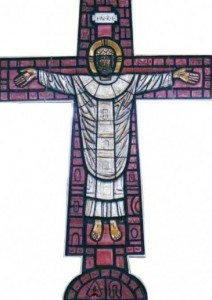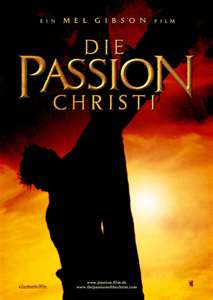The Passion of The Christ:
Posted by SociusSep 20
In this week’s blog, I want to put down some thoughts on the subject of Jesus’ Passion and Death – one of the most important and central tenets of our faith. Most of us Christians are familiar with the Crucifix – the sight of Jesus on the Cross – and, to be honest, it’s not a pretty sight. In simple terms, it portrays a man hung on a cross to die.
 |
The Crucifix above the High Altar – St. Mary’s, Leyland
Even so, the crucifix does not come near describing the stark sequence of events involved in an actual Roman crucifixion. Many people have taken the view that our accustomed modern statues and pictures of Jesus on the Cross are more realistic than the early and medieval, though still ‘watered down’ images of what took place – a bit like looking at something awful through tinted spectacles – so as to take away the worst impressions of what took place on Calvary. It is as though public consumption could not – cannot – cope with the actual violation of that once perfect human body.
 |
In order to portray the sufferings and death of Jesus, in a more true-to-life reality, the actor-cum-director, Mel Gibson, produced and directed the controversial film, ‘The Passion of The Christ’ in 2004. His attempt to describe the sufferings and death of Christ Our Saviour, in real terms, proved an upsetting experience for many people – Catholics among them – and many said that the film set out the sequence of events towards the end of Jesus’ life, in the very poorest of taste. The film was certainly not suitable for the very young, in my view, and many adults admitted that the some of the scenes were stomach-churning. I have heard many adults say they have no wish to see the film, for whatever reasons. Having, myself, watched the film, I have to say that it was certainly not an easy experience. It made me think very deeply about what was going on. My conclusion was that the director had made a conscious attempt to show his audience just what the arrest, public humiliation with all its indignities, the scourging and crowning with thorns, finally, the crucifixion and death of Jesus was like – what it would have been like to have been there – the scene in all its true colours.
 |
Jesus, Calvary and Mary – stills from the ‘Passion of the Christ’
That having been said, we must realise that despite Gibson’s attempts to bring home the true message of ‘The Passion of The Christ’, it falls short by a very wide margin. It cannot tell us what Jesus was like, truly, as a man. It cannot tell us, truly, what it was like for this Son of God to be treated as a criminal, worse than a murderer like Barabbas. It cannot describe for us, adequately, the injustice done to an innocent God-made-Man. It cannot take us there to see and hear the crowd, many eager to see Jesus crucified, many horrified at the sufferings being ‘dished out’ to a man who had done no wrong, many heart-broken for Jesus, his family and those who loved him. It cannot show us the fear and tremblings of a man about to be killed in the most brutal way – the moods of the people, the atmosphere of the scene, or that sense of dereliction, abandonment and aloneness of the figure at the centre of all this. It cannot convey the pain and blood-loss-weakness of a man whipped and crowned with long sharp thorns, the excruciating feel of nails being driven through the the wrist and through the ankles, then to be hung on a cross of rough-hewn wood. It never could show what it was like to hang on that cross for hours before death actually took away all that pain. We must never forget that, though Jesus was divine, he was also a man just like us and, therefore, able to experience injustice, abandonment, humiliation, ridicule, condemnation, pain, and the fear of oncoming death, just like all human beings.
If that was ever to be the end of the saga, then what a totally depressing conclusion it would bring us to imagine. Thank God, that is not the case. Thank God it is not just about suffering and death. Thank God, that is not the way it ends, for this is not just about that kind of downward spiral that leads to complete despair. Ultimately, it is about LOVE and HOPE. The story tells us about love, the love of one human being, for each and every one of us – love for the whole human race. It is about so much love contained in that one man, that he gave up his life for the rest of us, a sacrifice of divine proportions, more than sufficient to atone for the countless wrongs of humanity, thereby to save us from the threat of everlasting enmity towards God, our Father and Creator.
However, it is not easy to make the cosmic leap from that deep depression to the realisation that all this is about hope, wrapped in a great love; the leap across that void requires a leap of faith – faith, that wonderful gift that comes from God. However, this is not likely to happen all at once, like a spark, like a flash of lightening. Rather, it is a journey in faith that God allows us to travel more slowly, through all the experiences of our lives. In life we see the good and the bad, the evils that surround us everyday, (and always make the headlines), and, on the ‘other side of the coin’, the millions of people who lead good lives and who are deserving of happiness – all those who try to make the world a better place. To all of us, these are the experiences we have of life – lessons if you like – and the lessons become more and more intensified as we grow older and, hopefully, a little wiser. God is at work in all of this, teaching us about life and about his love for all of us, about his original design in his creation of the human race, and about his wish to see all of us united with him, in eternal happiness. So, the story is also about hope, the hope we now have of reconciliation with God, who loves us all – who loved us so much – that He gave us his own Son as a sacrifice, that we may be saved from eternal darkness – if only we say ‘sorry’ for our sins, and mean it.
We began with the sufferings and death of Jesus, our Saviour, a negative note of sadness and depression. Through faith we come to quite the opposite, all the positives of love, hope, reconciliation and forgiveness with the God who made us, who loves us, always and forever. But, what enfolds all of this is LOVE, the Love of God and the Love of Jesus, for without that binding love, that love which drove a man to undergo an ignominious death, we would have nothing to look forward to – nothing other than that deep, dark, godless void. Thank God for Jesus, now and always!
Socius
Readers are advised to go to the main blog site to view the blog in its original format.

No comments